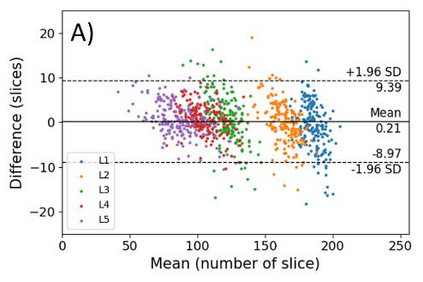Visually scoring lung involvement in systemic sclerosis from CT scans plays an important role in monitoring progression, but its labor intensiveness hinders practical application. We proposed, therefore, an automatic scoring framework that consists of two cascaded deep regression neural networks. The first (3D) network aims to predict the craniocaudal position of five anatomically defined scoring levels on the 3D CT scans. The second (2D) network receives the resulting 2D axial slices and predicts the scores. We used 227 3D CT scans to train and validate the first network, and the resulting 1135 axial slices were used in the second network. Two experts scored independently a subset of data to obtain intra- and interobserver variabilities and the ground truth for all data was obtained in consensus. To alleviate the unbalance in training labels in the second network, we introduced a sampling technique and to increase the diversity of the training samples synthetic data was generated, mimicking ground glass and reticulation patterns. The 4-fold cross validation showed that our proposed network achieved an average MAE of 5.90, 4.66 and 4.49, weighted kappa of 0.66, 0.58 and 0.65 for total score (TOT), ground glass (GG) and reticular pattern (RET), respectively. Our network performed slightly worse than the best experts on TOT and GG prediction but it has competitive performance on RET prediction and has the potential to be an objective alternative for the visual scoring of SSc in CT thorax studies.
翻译:第二个(2D)网络接收2Dx轴切片,并预测得分。我们使用227 3D CT扫描对第一个网络进行培训和验证,其结果是1135 xial 切片在第二个网络中应用。我们因此提议了一个自动评分框架,由两个连锁的深度后退神经网络组成。第一个(3D)网络旨在预测三维CT扫描中五种解剖式评分水平的硬盘位置。第二个(2D)网络接收由此产生的2Dx轴切片,并预测了分数。我们使用227 3D CT 扫描来培训和验证第一个网络,其结果是1135 xial 切片在第二个网络中应用。两个专家独立获得一组数据,以获得一组内部和观察者之间的差异和所有数据的地面真相。为了缓解第二个网络中培训标签的不平衡,我们引入了取样合成数据的多样性、地面玻璃和再解释模式。四倍交叉校验显示,我们拟议的网络在0.90、1.66和0.49之间平均MAE、0.48和0.48 和0.4的地面预测中,分别完成了对0.46和0.48的计算。










